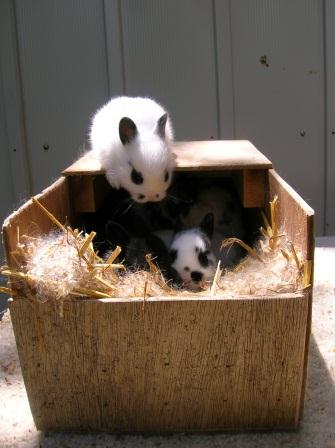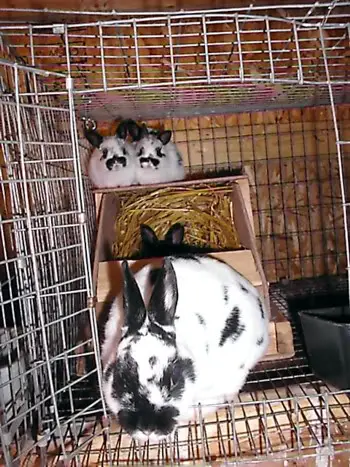by Laurie Stroupe.
Moving Kits to a Different Doe – An Important Tool for a Breeder
I foster kits to different dams all of the time. There are several different reasons why I will foster, and I’ll talk about that more, but first, let me tell you how I do it.
 I just pick up a kit and put it into another nest box.
I just pick up a kit and put it into another nest box.
That’s it. With newborns, I’ve never had a problem just slipping them into the nest I want them to be in. There’s no need for fanfare or big preparations.
There are a few details, of course. It is imperative that you mark kits if the coat color or breed is not enough to help you tell them apart. I use an unnatural color permanent marker in the ear. If I can see just a speck of lime green in a kit’s ear, then I know it’s the marked one. I used to use black. But a tiny speck of black might not tell me much and it can’t always be seen under the fur as it grows in.
Some breeders tattoo a dot in an ear. That has the distinct advantage of not needing remarking every other day. Coloring the ear with a permanent marker must be touched up every other day or it may fade. Some color will usually last for weeks, but do not count on it. Touch up the mark. You can also use nail polish on the out side of the ear. It sticks for a really long time.
There may be any number of great ways to mark kits. It’s just important that you do so. If you can’t determine which kit is which, then you turn your pedigreed rabbits into pets.
And the mark is no good if you don’t record which litter is the marked litter. If you need to mix three litters, then just two use different colors. Magenta is another good choice.
I am in the process of gradually moving May’s litter over to Molasses. Both were first-timers, so I was anxious to see how they would do. There’s a total of 6 viable kits. I really want to free up May to get in shape for Convention, but I don’t want to take any risk whatsoever with the kits. I’ve been watching their progress carefully and moving over one kit at a time, to make sure that Molasses has a milk supply to keep up and is diligent about taking care of the kits. Wouldn’t you know that May is the one with milk to spare? It’s always the way, isn’t it. Molasses is doing a fine job, though.
If Molasses had had previous litters and I had been comfortable with her track record, I would have moved them all over on day one.
When are kits too old to foster safely?
I have fostered kits as late as 19 days old. When I had a dying doe, I had absolutely no choice. I removed the foster mother from the cage and put the fostered kits in with hers for a couple of hours. I put a small dab of Vicks above her nose to inhibit her ability to smell. Other breeders use vanilla extract.
When I put her back in with the kits, she was obviously concerned that something was wrong. She checked the kits (it was cold weather, so they were still in a nest box for a couple more days). She glared at me, I swear. She repeated that and nosed around for about 15 minutes. And then, as if she decided that she couldn’t figure out what was wrong, she just hopped in and started nursing.
The Many Profitable Reasons to Foster
Now I have already alluded to two reasons to foster. One, you want to free up a doe, perhaps to sell her, or get her into shape to show, or to rebreed her more quickly.
Two, you may need to foster because the original dam is ill, not caring for the kits, or did not produce milk. (Take care that you understand a rabbit’s normal routine for caring for kits before you determine that she is not doing so – rabbits only feed their young once, perhaps twice, per day.)
Three, you do not want to have a litter of one kit. In cold weather, the kit is not able to keep warm. Also, it runs a huge risk of being overfed, which can affect its leg development. Likewise, you may not want a litter of just two kits.
Four, you do not want to have an overly large litter. Although some does can handle 7 or 8 kits, I prefer litters of 3 to 5, with 4 being my personal favorite. Evening out kits will provide enough warmth and milk for all, without stressing out or dragging down a doe. And, it helps kits be neither over- nor under-fed.
 Five, you want to help out a doe that has had a dead litter. I don’t have any proof of this, but it does seem to help a doe get started with live litters if she has the opportunity to nurse a litter. Even if it’s not true, why not have the non-producing doe nursing and let the producing doe get on with another litter? And if it does help the doe to have a live litter next time, then you are ahead of the game.
Five, you want to help out a doe that has had a dead litter. I don’t have any proof of this, but it does seem to help a doe get started with live litters if she has the opportunity to nurse a litter. Even if it’s not true, why not have the non-producing doe nursing and let the producing doe get on with another litter? And if it does help the doe to have a live litter next time, then you are ahead of the game.
Six, you don’t want to allow an older doe too much time between litters. Older does are running out of time. Perhaps you want to get more kits from her before she quits producing. Or, you are keeping her in production to extend her productive years (months). Either way, I often foster kits from valuable older does in an attempt to get an extra litter or two from her.
To foster kits to a doe that you are unsure of, you may choose to tandem nurse them for a few days until you are sure that the doe’s milk is ample and her mothering skills are intact. Just remove the nest box and raise the babies on a shelf. Give the box to one doe in the morning and the other doe in the evening. Once you are sure that the foster mother will work out, you can give her the box full-time or contiue to raise them on the shelf, only returning them just to the foster mother.
If you need to foster more kits than a doe would normally be able to handle, you may want to split the litter. I had a doe with 7 kits who suddenly had to take on 5 more because the second doe did not produce any milk whatsoever. I raised both litters on the shelf and gave her one litter in the morning and the other litter in the evening. She did this successfully for several days until other does delivered their litters and were able to take some of the kits from her.
Don’t be afraid to foster between breeds. That’s no problem. Some breeds are even known for having ample supplies of milk or having good mothering abilities.
Fostering is but one of the tools you have to help you run your rabbitry and optimize your breeding program. If you having tried it before, be brave and go for it. I think you will like the results.

Next Article: Keeping Wandering babies safe
